Keeping your embroidery space neat can be a challenge, but learning how to organize embroidery threads makes everything easier and more fun. Imagine starting a project and finding the right thread instantly without any mess! In this article, we’ll explore simple and effective ways to store and arrange your embroidery threads using an embroidery thread organizer.
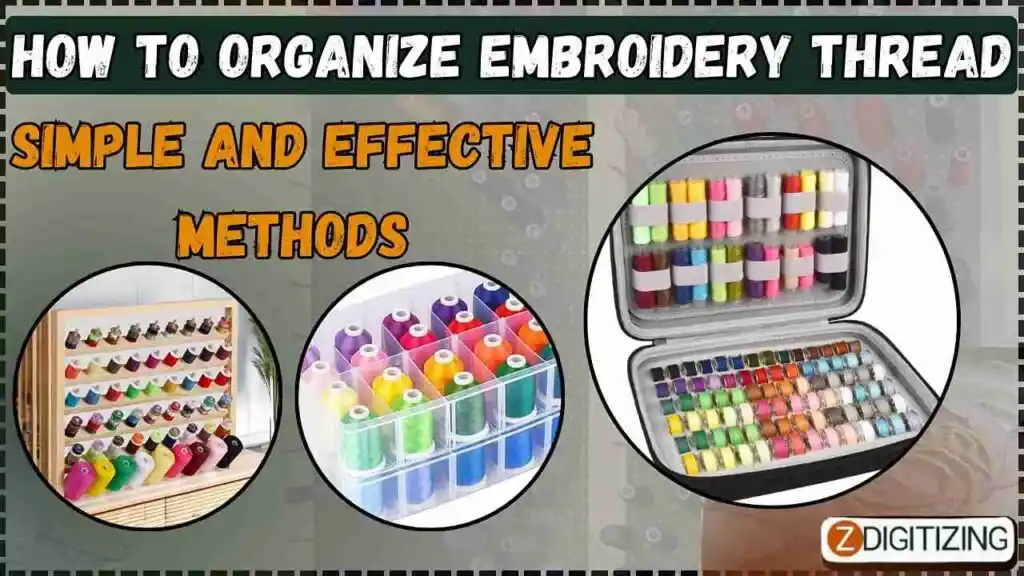
We’ll guide you through practical tips to keep your threads organized and ready for your next project.
How to Organize Embroidery Thread
Why Organizing Embroidery Thread Is Important?
- Easy Color Selection: Quickly find the right color without hassle, making project planning easier.
- Prevents Tangles and Damage: Proper storage keeps threads tangle-free and protects them from dirt, moisture, and fading.
- Maximizes Thread Usage: Organized threads help you use up partial skeins, saving money and reducing waste.
- Boosts Creativity: Neatly arranged threads inspire new color palettes and project ideas.
- Simplifies Project Planning: Organized threads make it easier to gather all materials for your next project.
Embroidery Digitizing & Vector Art Services

Looking for embroidery digitizing and vector art services that are affordable and reliable? We offer fast turnaround time, guaranteed quality, and the option to preview your design before payment, we make sure you get exactly what you need. Your satisfaction is our top priority, and we’re dedicated to delivering the best results. Don’t wait—try ZDigitizing today and see the difference in quality and service!
Embroidery Digitizing & Vector Art Services
Looking for embroidery digitizing and vector art services that are affordable and reliable? We offer fast turnaround time, guaranteed quality, and the option to preview your design before payment, we make sure you get exactly what you need. Your satisfaction is our top priority, and we’re dedicated to delivering the best results. Don’t wait—try ZDigitizing today and see the difference in quality and service!
Methods to Organize Embroidery Thread Effectively
Organizing your embroidery thread the right way can make your crafting smoother and keep your space tidy. Here are some great methods to find the best embroidery thread organizer that helps you manage your threads neatly, no matter how much space you have:
- Pegboard Thread Rack
- Binder Ring System
- Clear Storage Boxes
- Thread Drawer Dividers
- Wall-Mounted Thread Holder
- Bobbin Box Organizers
- Magnetic Strip Holders
- Foam Pool Noodle Organizer
- DIY Cardboard Thread Cards
- Embroidery Floss Bobbins in Organizer Box
We’ve quickly looked at the best ways to organize embroidery thread; now let’s dive into the details of each embroidery thread spool organizer method so you can better understand which one you should choose.
1. Pegboard Thread Rack
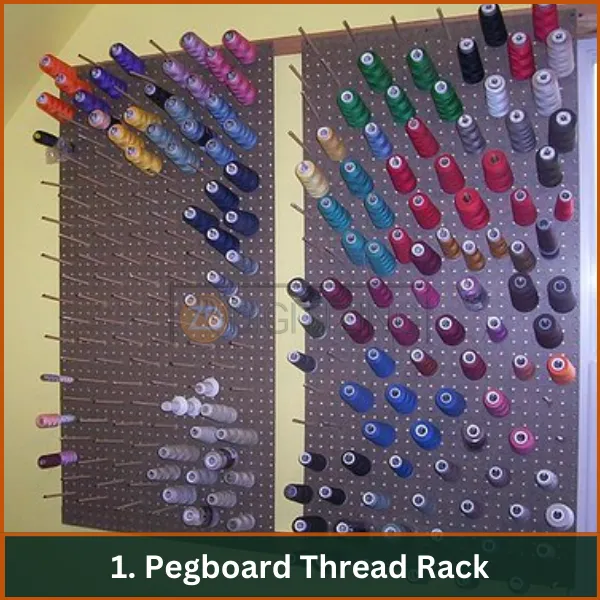
The pegboard thread rack is a customizable board with pegs designed to hold each spool or skein of thread. Mounted on the wall, it allows embroiderers to display their thread colors openly, making selection quick and straightforward. It helps you organize embroidery thread while keeping your space neat and clutter-free.
Benefits:
- Visibility: All thread colors are displayed openly, making it easy to pick the exact shade you need without rummaging through boxes or drawers.
- Customizability: You can arrange and rearrange the pegs to accommodate different sizes and types of thread spools, tailoring the setup to your specific needs.
- Space Efficiency: By utilizing vertical space on a wall, the pegboard keeps work surfaces clear and threads neatly organized, which is especially beneficial in smaller crafting areas.
Drawbacks:
Space Requirement: It requires free wall space, which might not be available in smaller or already crowded craft rooms.
Best Use:
This is perfect for crafters who have a specific area dedicated to crafting and like to visually manage their resources. It works especially well if you like to have everything visible for inspiration and quick access during projects.
2. Binder Ring System
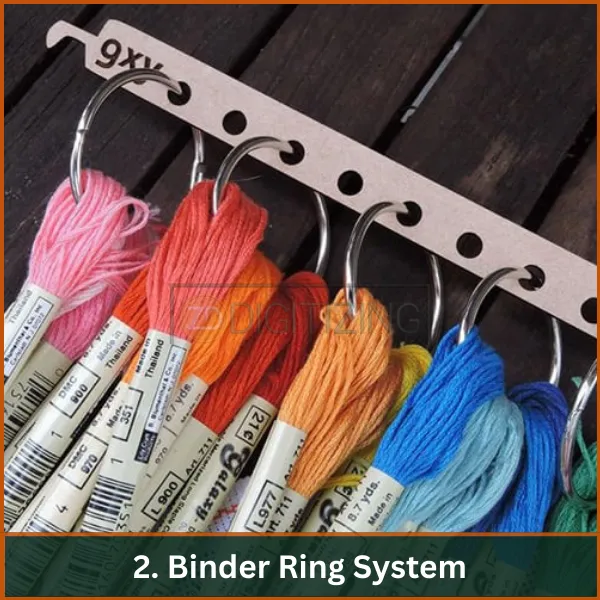
This system involves securing floss skeins through binder rings, which are then categorized and stored in a binder or hung on hooks. It’s a flexible and mobile method, allowing crafters to carry their threads from one location to another effortlessly. This is an easy way to organize embroidery thread if you’re often on the go
Benefits:
- Portability: Extremely lightweight and portable, perfect for crafters who attend workshops or craft groups.
- Organization: Floss can be sorted by color, type, or project, and labeled for easy identification, making it simple to find exactly what you need quickly.
- Space-Saving: The binder ring system occupies minimal space, fitting neatly into craft bags or small storage areas.
Drawbacks:
- Tangle Risk: If floss is not properly secured, it can slip out of the rings and become tangled, which can be frustrating and time-consuming to resolve.
Best Use:
Great for those who frequently travel with their crafts, attend workshops, or have limited storage space at home. It’s also ideal for teachers or instructors who need to bring materials to different classrooms or locations.
3. Clear Storage Boxes
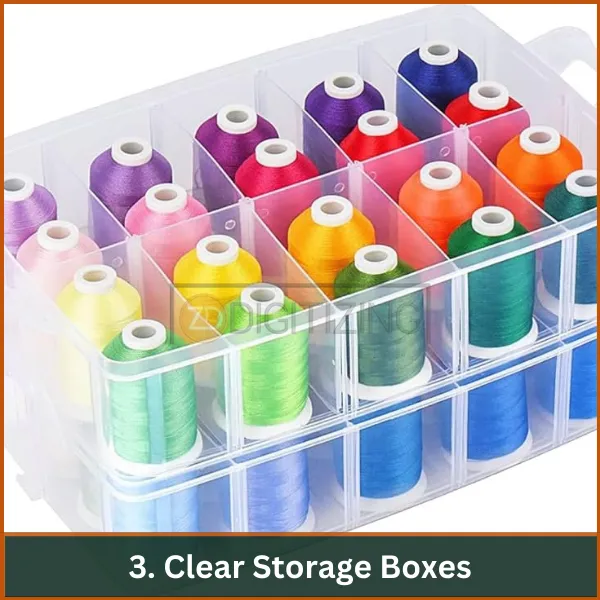
Clear storage boxes are segmented, transparent containers designed to keep different colors and types of threads separated and visible. They provide excellent protection against dust and moisture, preserving the quality of the floss.
Benefits:
- Protection: Floss is shielded from environmental elements like dust and moisture, which can degrade quality over time.
- Visibility: Because the boxes are transparent, it’s easy to see the contents without opening each box, saving time and effort during crafting sessions.
- Organization: The compartments can be labeled, and threads sorted by various categories, making management straightforward and efficient.
Drawbacks:
- Bulkiness: Depending on the size and number of boxes, they can take up considerable space, which might be an issue in smaller crafting areas.
Best Use:
Suited for crafters who have a permanent crafting space with shelves and prefer to keep their materials dust-free and neatly organized. It’s also ideal for those who appreciate a visual inventory without needing to open each container.
4. Thread Drawer Dividers
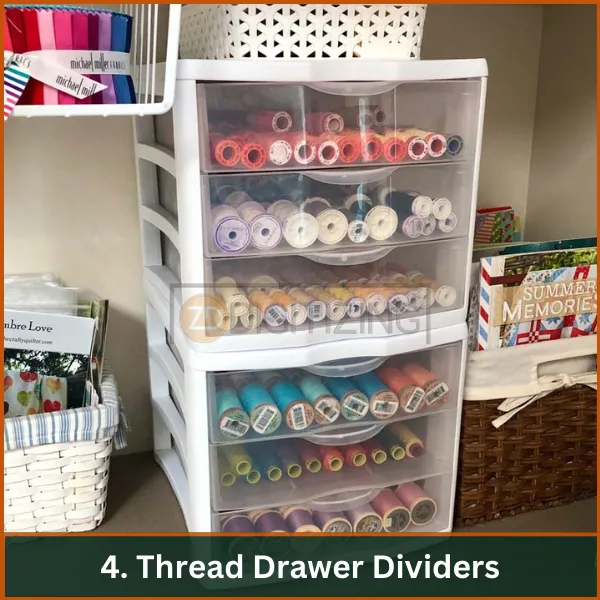
Drawer dividers convert standard drawers into organized storage spaces by segmenting them into smaller compartments tailored for embroidery threads. This is an efficient way to organize embroidery threads if you prefer to keep your threads tucked away neatly and out of sight
Benefits:
- Integration: Utilizes existing furniture, thus not requiring additional space for thread storage.
- Aesthetic: By keeping threads out of sight, it helps maintain a neat and orderly crafting environment.
- Customization: Dividers are adjustable and can be fitted to various drawer sizes, making them versatile and accommodating to different storage needs.
Drawbacks:
- Visibility: Retrieving specific threads can be more challenging as they are not immediately visible upon opening the drawer.
Best Use:
Perfect for those who prefer a clean and uncluttered workspace and like to integrate their craft storage within existing furniture. This method helps maintain a minimalist environment and is excellent for use in multi-purpose spaces.
5. Wall-Mounted Thread Holder
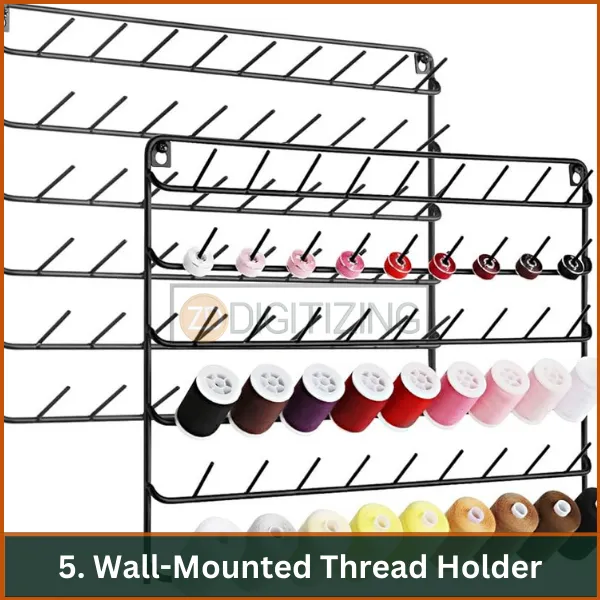
Wall-mounted thread holders feature rods or hooks from which threads are hung. It’s a creative way to enhance your embroidery thread organization while adding a decorative touch to your room.
Benefits:
- Decorative Appeal: It can be used to create a visually appealing display of embroidery threads that enhances the decor of the crafting space.
- Accessibility: Threads are easily accessible and can be organized by color or type, which speeds up the selection process during crafting.
- Space Conservation: Utilizes wall space efficiently, which is particularly advantageous in areas where floor or shelf space is limited.
Drawbacks:
- Exposure to Elements: Threads may be subjected to dust and direct sunlight, which could potentially fade colors and degrade materials over time.
Best Use:
Ideal for those who value aesthetics along with functionality. If you enjoy making your craft supplies a part of your home decor and have available wall space, this method can add a creative touch while keeping threads readily accessible.
6. Bobbin Box Organizers
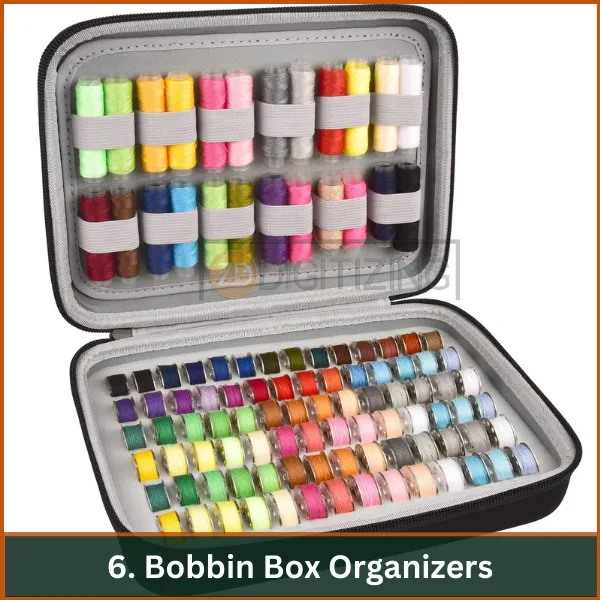
Bobbin box organizers are small containers divided into compartments designed specifically to hold bobbins wrapped with embroidery threads. These boxes can be easily stored in a drawer or crafting shelf. They’re great for keeping things tidy and help you organize embroidery thread efficiently.
Benefits:
- Compact and Neat: Keeps bobbins securely in place, preventing them from unwinding or tangling.
- Portable: Small and lightweight, making them easy to transport for on-the-go crafting.
- Visible Organization: Some boxes are transparent, allowing you to see the colors without opening the box.
Drawbacks:
- Limited Capacity: Each compartment holds only one bobbin, which may not be sufficient for those with large thread collections.
Best Use:
Excellent for those who frequently switch between different thread colors and types, such as quilters or sewers who work on multiple projects simultaneously. It’s also great for organizing small crafting spaces.
7. Magnetic Strip Holders
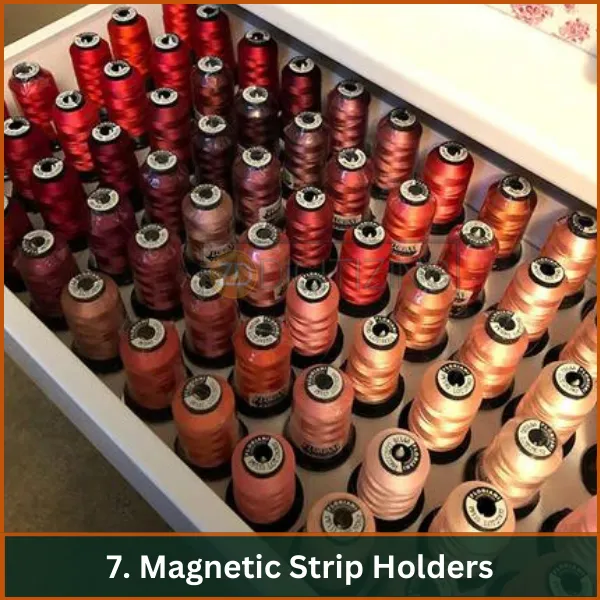
Magnetic strip holders use powerful magnets to hold metal bobbins or clips that contain embroidery threads. This sleek and modern way to organize embroidery thread can be mounted on any wall or desk, keeping your workspace clear.
Benefits:
- Space-Saving: Efficiently uses wall space, keeping counters and drawers free.
- Quick Access: Allows for easy and quick access to threads, speeding up the embroidery process.
- Minimalist Design: Offers a clean and modern look, enhancing the aesthetic of your crafting space.
Drawbacks:
Compatibility: Only suitable for metal bobbins or clips, limiting its use with other types of thread storage.
Best Use:
Perfect for modern craft rooms or studios where a sleek, minimalistic design is preferred. It’s also ideal for quick projects where easy access to different threads is necessary.
8. Foam Pool Noodle Organizer
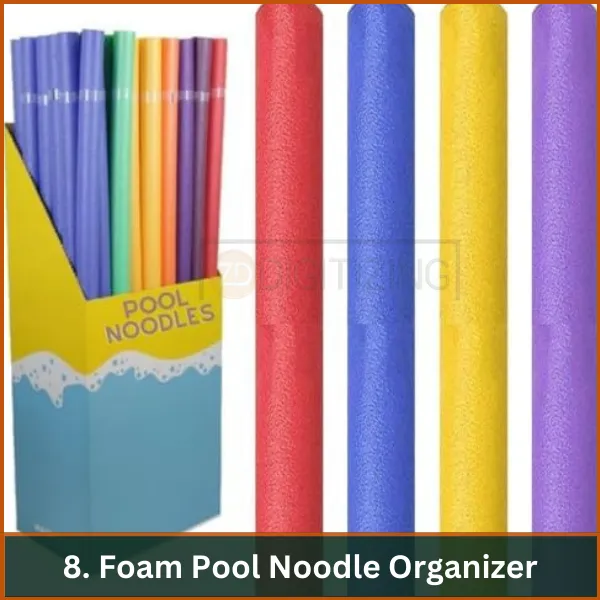
A foam pool noodle can be converted into a thread organizer by slicing it into sections and making slits to hold embroidery threads. This DIY solution is both fun and functional.
Benefits:
- Inexpensive: Utilizes a common household item, making it a cost-effective storage solution.
- Customizable: Can be cut to fit any space and accommodate as many threads as needed.
- Creative and Colorful: Adds a playful and personalized touch to your crafting area.
Drawbacks:
- Less Durable: Foam may wear out over time, especially with frequent use.
Best Use:
This method is great for crafters who are looking for a budget-friendly storage solution and have ample space to accommodate a larger setup. It’s also a fun project for those who enjoy DIY solutions.
9. DIY Cardboard Thread Cards
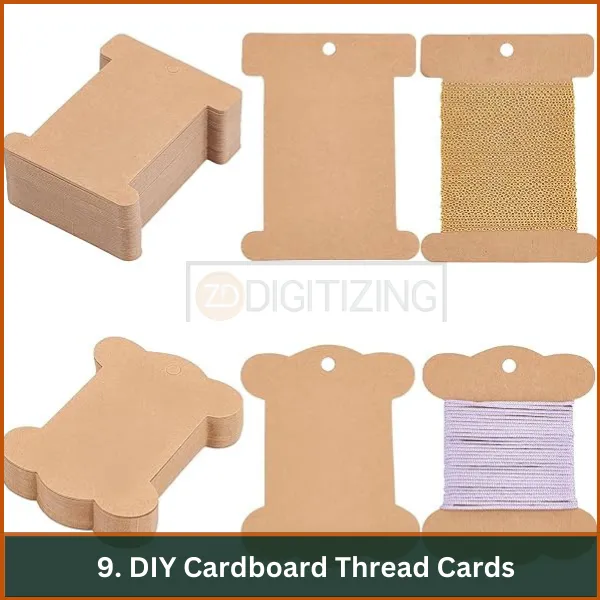
Cardboard thread cards are a creative and eco-friendly way to organize embroidery thread. They are made by cutting cardboard into desired shapes and creating notches to wrap embroidery threads around them.
Benefits:
- Eco-Friendly: Makes use of recycled materials.
- Highly Customizable: Can be tailored to various sizes and shapes based on your storage needs.
- Cost-Effective: Utilizes readily available materials, minimizing expenses.
Drawbacks:
- Durability: Cardboard is not as durable as other materials and may need to be replaced more frequently.
Best Use:
Best suited for environmentally conscious crafters who prefer to upcycle materials. This method allows for personalized organization and is ideal for temporary or project-specific thread sorting
10. Embroidery Floss Bobbins in Organizer Box
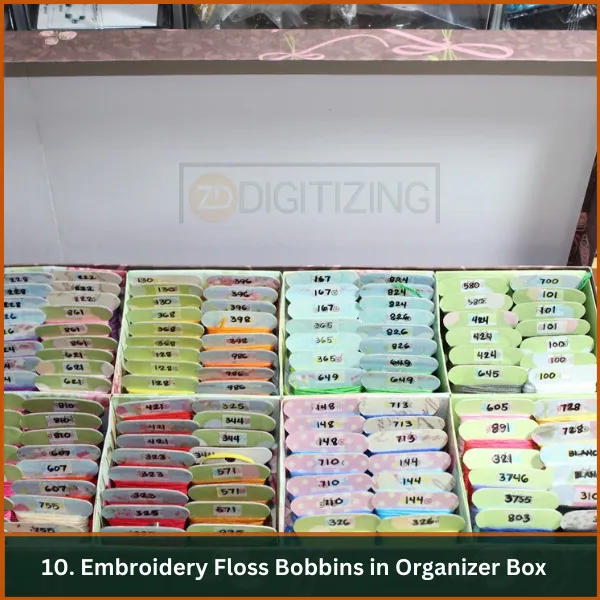
This traditional method involves winding embroidery threads around cardboard or plastic bobbins, which are then organized in a segmented box. Winding threads onto bobbins and placing them in an organizer box is a tried-and-true method to organize embroidery thread.
Benefits:
- Organized and Tidy: Keeps threads neatly wound and categorized, making it easy to find the color you need.
- Prevents Tangles: Each thread is wound on its own bobbin, reducing the risk of knots and tangles.
- Versatile Storage: Boxes come in various sizes and can be stored in drawers, shelves, or taken on the go.
Drawbacks:
- Time-Consuming Setup: Initially setting up and winding the threads onto bobbins can be time-consuming.
Best Use:
This is an excellent choice for those with extensive thread collections that need to be meticulously organized. It’s particularly useful for professional embroiderers or those engaged in intricate embroidery projects that require many different colors.
Embroidery Digitizing & Vector Art Services

Looking for embroidery digitizing and vector art services that are affordable and reliable? We offer fast turnaround time, guaranteed quality, and the option to preview your design before payment, we make sure you get exactly what you need. Your satisfaction is our top priority, and we’re dedicated to delivering the best results. Don’t wait—try ZDigitizing today and see the difference in quality and service!
Embroidery Digitizing & Vector Art Services
Looking for embroidery digitizing and vector art services that are affordable and reliable? We offer fast turnaround time, guaranteed quality, and the option to preview your design before payment, we make sure you get exactly what you need. Your satisfaction is our top priority, and we’re dedicated to delivering the best results. Don’t wait—try ZDigitizing today and see the difference in quality and service!
Exploring Alternative Methods for Thread Storage
Exploring alternative methods for thread storage opens up creative possibilities for keeping your sewing essentials organized and readily accessible.
Using Mason Jars or Glass Containers for Thread Display
If you’re a fan of rustic charm or appreciate seeing your thread collection at a glance, using mason jars or glass containers is a fabulously creative alternative.
Arrange your threads in color order, pop them into the jars, and voila! You’ve got yourself a beautiful and practical display that adds a touch of whimsy to your stitching space.
Utilizing Magnetic Strips or Boards for Thread Organization
Magnetic strips or boards are a nifty option for organizing your embroidery threads. Simply attach your thread spools to the magnetic surface, and they’ll stay in place and be ready to use whenever you need them.
This method is not only space-saving but also prevents your threads from unruly tangling. Plus, it’s like having your own little thread art gallery on your wall!
Thinking Outside the Box With Unconventional Thread Storage Solutions
If you’re feeling adventurous and want to add a touch of quirkiness to your thread organization, why not think outside the box?
You can repurpose old spice racks, and jewelry organizers, or even create a custom-made hanging thread display using embroidery hoops.
The possibilities are endless, and the result will be a unique and personalized thread storage solution that reflects your creativity.
Conclusion
Organizing your embroidery thread can be simple and fun with these ten creative methods. Choose from storage containers, custom racks, pegboards, or other solutions to keep your threads tidy and ready for use.
With everything neatly arranged, you’ll find the perfect color faster and enjoy your embroidery more.
Looking for top-quality embroidery digitizing services? ZDigitizing is your go-to spot! We provide excellent embroidery digitizing and vector art services tailored to your needs. Plus, get 50% off your first order!
It’s easy to start—just reach out for a free quote, and we’ll get back to you in just 5 minutes. If you found this article helpful, share it with friends and let them know about our fantastic services and discounts.
Thank you for reading, and we look forward to assisting with your embroidery projects!
FAQs
The best way to organize embroidery floss is by using floss organizers or bobbins, labeling each with its color number, and storing them in compartmentalized boxes or drawers for easy visibility and access.
The best way to store spools of thread is on a thread rack that can be wall-mounted or placed on a table, allowing for easy organization by color or type and protecting the thread from dust and sunlight.
Best ways to store thread include using clear plastic containers with dividers for small spools, wall-mounted racks for easy access, and airtight bins for bulk or less frequently used threads to protect from moisture and dust.












